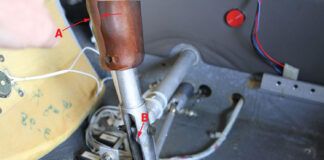Thats fine if you need a cut not longer than an inch or so, but what if you want a long taper? Obviously, that technique will work again if the total cut length is within the capability of the compound slide, but what if you need, say, 10 inches? Doing it with a file is as ugly as a hairless Chihuahua with an attitude, so lets use some more of the capabilities inherent in the lathe.
Well take advantage of the fact that the longest motion of the lathes three axes is in the X direction, and put the stock at an angle relative to that axis. We’ve a problem, though, because the three- and four-jaw chucks are designed to align the material along that X axis. So we wont use those chucks; instead, well suspend the material between two points and then shift the tailstock off-center. Then all we need to do is transfer the torque of the lathe into the stock, crank the tooling along the X axis, and we’ve got it. Simple.
Thats the basic idea, but now lets get into the details.
There are three steps to cutting a taper:
1. Calculate the offset.
2. Make the adjustment.
3. Do the cutting.
You’ve been working with the lathe a bit and probably used the tailstock-mounted drill chuck to knock a hole or two in the center of the material. Lets start by making sure you’re really on-center.
The first thing to do is make a tool to help you set the offset and then get everything back on-center when you’re done. This tool is simply a bit of round stock you suspend between two centers. It has a conical indentation on each end that hangs on the centers, and a zone at each end thats turned to equal diameters. Those zones will be targets for the dial indicator.
So chuck up a bit of stock about 12 inches long with a 1-inch diameter. Face off one end, and then use a large center drill to create the depression. Don’t drill to the maximum outside diameter of the bit; you want to use the conical surface as load-bearing area.
We have a seeming contradiction here: How can I drill a hole on-center without having first aligned the tailstock? The answer is to eyeball it as close as possible, knowing that the drill will find the center of rotation if you’re not too far off. You wont get an accurate hole; itll be larger at the opening than at the bottom. For starters, though, its OK. Finish this end by taking a light cut for an inch or so on the OD. When you have a good finish, lock the Y axis down. Now turn the material around and repeat this treatment on the other end. You locked down the Y axis, so you should be getting a cut of the same diameter on this end.
You just made your first tool, so don’t damage it! Mark it “Do not use as a hammer!” and plan on keeping it in a safe place. But first, lets use it.
What’s Needed
You might need to buy some more tooling before you go any further. (Oh, darn! Grin.) Specifically, you’ll need a dead-center, a live-center, a faceplate and a lathe dog. First, some definitions.
Dead-center: A solid hunk of metal with a long taper at one end and a point on the other. (I used to work for a guy like this, except he seldom had a point.) It fits in the headstock.
Live-center: Same as a dead-center, except the point turns on ball bearings. It will be inserted into the tailstock.
Faceplate: A flat, round plate about 8 inches in diameter with various slots and holes. It fits in place of the three-jaw chuck.
Lathe dog: The shop mascot? No, its a tool to transfer torque to the material. The work piece is clamped into the center of it, and the leg of the dog slips into one of the slots on the faceplate.
Morse TapersTo set this up you start by removing the drill chuck from the tailstock by simply cranking it backward until it comes loose. Youll notice that there’s no apparent clamping mechanism, no bolt, seemingly nothing to inhibit rotation of the chuck when drilling.
That shiny, smooth, tapered surface…thats the key. Chances are its a Morse Taper. The caveat is simply because there are several configurations that all look alike without the aid of a micrometer, but Morse is the most common configuration in small tools.
Now Ill drop the other shoe: There are eight sizes of Morse Taper. Hang in there.
Its really pretty easy. First, Morse Tapers are, well, tapered about 5/8 inch/foot. Im not making that a decimal because it would be a misleading accuracy in that the eight sizes all have different tapers ranging from 0.59858 inch/foot to 0.63151 inch/foot. Knowing that its likely you have a Morse Taper in front of you, all you need do to determine the type is to measure the small diameter of the ground surface and refer to the chart.
With that knowledge in hand, you might ask, “How does it resist rotation with no obvious clamping surface?” The answer: Friction. Yep, simple friction between two matching surfaces is all it takes. That means those surfaces have to be very clean. Wipe them down with a new, lint-free rag and alcohol or acetone and let them dry. Hold that thought and then take a not-too-close look at a group of tools configured with a Morse Taper and you’ll see a nice, fat, flat-sided tang on some. Its the exception that proves the rule.
Chances are you got a dead-center, maybe two, when you bought your lathe. But you’ll likely have to buy a live-center, so knowing which Morse Taper you need is critical. When you look them up theyll be labeled MT 0 through MT 7. Youll probably need MT 3 or MT 4.
Obviously, with a tapered profile, the three- or four-jaw chuck isn’t going to hold a dead-center very well, so remove whatever chuck you have on the headstock and install the faceplate. My machine uses a simple bolt-on configuration. More sophisticated lathes use a special wrench. Youll have to figure it out by, dare I say it, reading the manual. Again, cleanliness is paramount here. Any grit or, as the Brits say, swarf, will totally defeat what were trying to do.
The dead-center will likely pop right into place at the center of the faceplate. To free it from the headstock, you’ll need a hammer and a long rod. Tap loose. Be sure to catch it, though.
At the other end, the tailstock, you’ll need a live-center. Its probably not on the shelf, so heres where you put that knowledge of Morse Tapers to use. Of course, you could use a dead-center on both ends, and Ill enumerate the pros and cons after we’ve gone through the entire setup.
Make sure your live-center is clean and dry and then give it a quick, slide-in motion to lock it in place. You don’t need to tap it with a hammer to seat it! To get it out, just back up on the hand wheel; there’s a pin inside the tailstock that will push the taper out. We don’t need the dog just yet. Well save that for the work when we actually turn the taper.
For the moment, suspend that bar between the tapers. You don’t need to crank in hard on the tailstock; a light touch, just enough to remove any slack, is perfect. Don’t forget to lock down the tailstock, as you want it to be solidly in place.
Now its a simple job of using the dial indicator to put the tailstock perfectly concentric to the headstock. Just put the indicator on the cross slide, take a reading at the left end of your bar, run it down to the right of the bar, loosen the tailstock cross lock-nuts and, probably with an Allen wrench, adjust the Y position of the right end of the bar until the dial indicator matches the headstock end. Simple.
Don’t Panic
You might (I hope not) find that even though you can align the tailstock to the headstock in the horizontal plane, the tailstock is higher or lower than it should be. If thats the case, you’ll have to lap the tailstock to lower it, or shim it to raise it. Both of those procedures are well beyond the scope of this series. Sorry. But don’t put a for-sale sign on your lathe yet. Its not likely that you’ll need to adjust this and, even if its out, it will probably not be out much. Now that you know how to align it, lets move it where we need it.
The Calculation
Say you need a taper of 0.025 inch/1 inch. My test bar is 10 inches between the two test points, so I need to move the tailstock over 10 times that, 0.025 to 0.250 inch, right? Ah, you’re about to gain some experience! Don’t forget that on a lathe, you remove the material from one side, and then the material is turned over to cut the other side. That is, you cut the radius, but reduce the diameter. So you need to move the tailstock over half that distance. 0.250/2 = 0.125.
It matters not if your bar is 6 inches or 13.125 inches long. Just figure out the ratio (thats why I have a 10-inch bar), and don’t forget that last radius-to-diameter element in the calculation.
Danger, Will Robinson! Another “dont forget” is the bolts that clamp the tailstock in place.
The Cut
–Oscar WildeThe lathe dog now comes into play (Down, boy!). You could just clamp it on the end of the material, but that screw can make a nasty gouge in the stock. I like to wrap a bit of thin aluminum around the stock and clamp on that. The part is going to be centered on the (dont get ahead of me here) dead-center, so that extra bit of material will have no effect on the position. The leg of the dog fits into one of those slots on the faceplate.Put a dab of grease on each end of your stock, and lightly clamp it between the centers. You might think you don’t need grease on the live-center; after all, it has ball bearings. And there’s no relative rotation between the dead-center and the stock, so why should you grease that?
The answer is that there is relative motion at both ends-a sliding motion. Look closely at the interface between the point and the material, and you’ll see that the centers touch on the sides of the holes you made in the stock. As the material rotates, the point of contact changes, so a bit of grease helps this relative motion. I like to use a small shot of motorcycle chain lube because its really sticky once it sets up.
But as I said earlier, you can use a dead-center on both ends. By now the advantage of the live-center should be apparent, but if you’re doing light work and/or doing this rarely, a dead-center may be just fine. Simply watch for scoring on the tailstock dead-center, and don’t overload it. Itll overheat and can even wear the material enough to ruin the setup. Grease helps, but its not perfect here.
How tight the tailstock live-center should be is not hard to determine: The material should easily rotate within the limits of the lathe dog but have zero rattle when moved transversely.
Now before you go any further, stop everything you’re doing and take a close look at the setup. If the tailstock was moved away from you, the small end of the taper will be near the headstock. That means that you are cutting from right to left, and the load of cutting is on the dead-center in the headstock, as it should be. If you must have the taper going the other way (maybe its a material shape that wont fit any other way), then the tailstock should be shifted toward you. Now you realize why you got a ball-bearing tailstock: It can take that load.
Set your speeds depending on the diameter and take a light cut. Alls well? Take a couple more cuts. Now take some diameter measurements and, knowing the ratios described earlier, check that you’re getting the taper you expect.
Keep in mind here that this might be the classic long, thin rod, so chatter could be a problem. We are creating a taper, so you wont be able to use the follow-rest. Youll have to just go at it with a slightly higher rpm or with a lighter cut. When you’re done, put the test bar back in place, and bring the tailstock back on-center. Don’t worry about making it perfect on your first try. Just make a sign to put it in the shop:
“Experience is the name everyone gives to their mistakes.”
Editors note: If you have specific questions for author Bob Fritz, or if you have certain projects youd like us to cover, email us at [email protected] with “Home Machinist” in the subject line.




